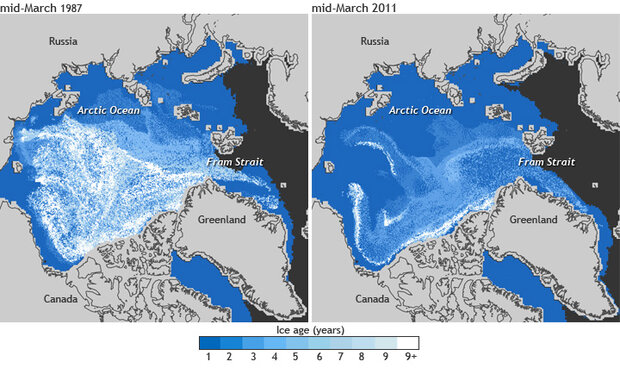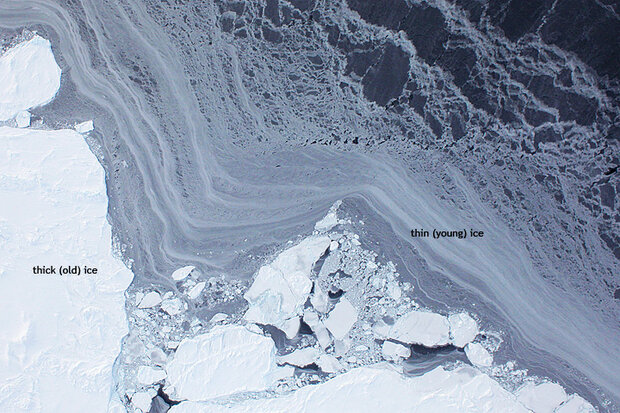A sea change in the Arctic atmosphere
In the dim light of early spring in the Arctic, a high-resolution digital camera on a NASA research plane shot the photo below while flying over the Arctic Ocean. The photo documents what polar scientists mean when they describe the "thinning blanket" of sea ice across the Arctic Ocean. Compared to older, thicker ice (left), the young, thin ice (right) is more transparent, with numerous cracks and openings.
NASA image captured March 26, 2011. Provided by the Digital Mapping System team and Operation IceBridge Arctic 2011, via NASA’s Earth Observatory.
Scientists have documented many ways in which the declining sea ice has a cascading impact on the rest of the Arctic environment, from loss of marine mammal habitat to amplifying warming. Now they have demonstrated another: more springtime ozone-depletion events, and probably more mercury contamination.
The sea ice and mercury changes are linked chemically through bromine. Sea ice controls the way bromine escapes from seawater into the air. Roaming the atmosphere, bromine can do two things. It can chemically scrub out ozone-normally not a bad thing in the Arctic, where a portion of ground-level ozone is a result of air pollution from the mid-latitudes-and it can transform an unreactive form of mercury into a reactive form.
Reactive mercury can fall out of the atmosphere into snow, ice and the ocean. "It is this converted form of mercury that can be incorporated into Arctic food chains in the ocean and on land," said Samuel Oltmans, an atmospheric scientist with NOAA's Earth System Research Laboratory and the Cooperative Institute for Research in Environmental Sciences. At high enough levels, mercury can harm organisms' nerves, brains, reproductive systems and more, depending on the form of the metal and type of exposure.
Scientists have already learned that springtime sea ice in the Arctic is much thinner than it was in the past, with far less multi-year ice. And other scientists have shown that thin "annual" ice (ice that formed during the previous winter and is riddled with cracks) is better at promoting bromine-related ozone destruction than thick, sturdy multi-year ice.

In the new study, Oltmans and his colleagues pull the story together, showing that ground-level ozone-depletion events are significantly more common during the month of March in recent years than they were just a few decades ago.
"In the first half of the record, ozone depletion events were rare, occurring less than 15 percent of the time in March," Oltmans said. But since 1993, ozone depletion events have occurred more than 25 percent of the time.
He and his colleagues showed that the increase in ozone-scrubbing events is not related to changes in wind patterns in the Arctic; rather, it appears that the thinner ice is promoting the changes in chemistry.
And that, Oltmans suspects, is bad news for Arctic ecosystems already well-known to suffer from mercury contamination. If warming continues, leading to more ozone-depletion events, that may well also mean that mercury is slipping more easily into Arctic food webs.
"In addition to measuring ozone, we will also want to routinely track mercury levels," Oltmans said, "since it is the mercury compounds that have the most direct environmental implications for the Arctic."
Reviewer: Sam Oltmans, NOAA's Earth System Research Laboratory and the Cooperative Institute for Research in Environmental Sciences.
References Oltmans, S. J., Johnson, B. J., & Harris, J. M. (2012). Springtime boundary layer ozone depletion at Barrow, Alaska: Meteorological influence, year-to-year variation, and long-term change. Journal of Geophysical Research, 117, 18 PP. doi:201210.1029/2011JD016889
Steffen, A., Douglas, T., Amyot, M., Ariya, P., Aspmo, K., Berg, T., Bottenheim, J., et al. (2008). A synthesis of atmospheric mercury depletion event chemistry in the atmosphere and snow. Atmospheric Chemistry and Physics, 8(6), 1445–1482. doi:10.5194/acp-8-1445-2008
Links Flying Over Arctic Sea Ice Mercury Research at NOAA's Air Resources Laboratory Cold Conspirators: Ice Crystals Implicated in Arctic Pollution NASA finds sea ice driving Arctic air pollutants
![]()
